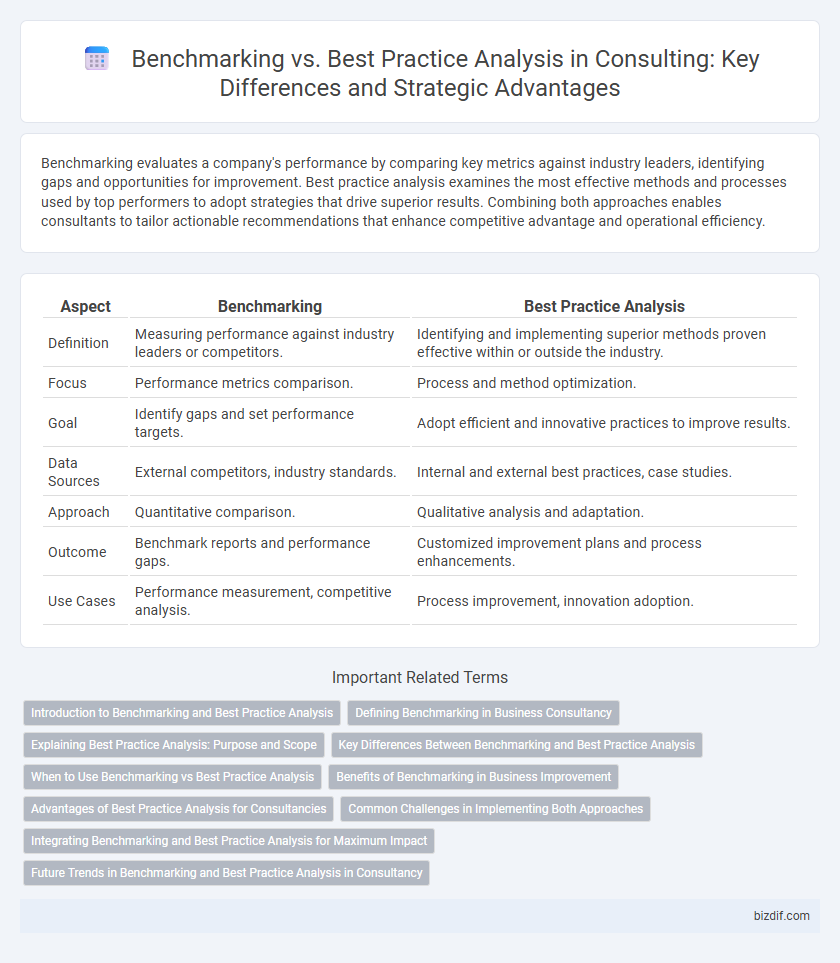Benchmarking evaluates a company's performance by comparing key metrics against industry leaders, identifying gaps and opportunities for improvement. Best practice analysis examines the most effective methods and processes used by top performers to adopt strategies that drive superior results. Combining both approaches enables consultants to tailor actionable recommendations that enhance competitive advantage and operational efficiency.
Table of Comparison
| Aspect | Benchmarking | Best Practice Analysis |
|---|---|---|
| Definition | Measuring performance against industry leaders or competitors. | Identifying and implementing superior methods proven effective within or outside the industry. |
| Focus | Performance metrics comparison. | Process and method optimization. |
| Goal | Identify gaps and set performance targets. | Adopt efficient and innovative practices to improve results. |
| Data Sources | External competitors, industry standards. | Internal and external best practices, case studies. |
| Approach | Quantitative comparison. | Qualitative analysis and adaptation. |
| Outcome | Benchmark reports and performance gaps. | Customized improvement plans and process enhancements. |
| Use Cases | Performance measurement, competitive analysis. | Process improvement, innovation adoption. |
Introduction to Benchmarking and Best Practice Analysis
Benchmarking involves systematically comparing an organization's processes, performance metrics, and strategies against industry leaders to identify gaps and improvement opportunities. Best Practice Analysis focuses on identifying and implementing the most effective methods and techniques proven to yield superior results within a specific domain. Both approaches drive operational excellence by leveraging external insights to enhance internal capabilities and competitive advantage.
Defining Benchmarking in Business Consultancy
Benchmarking in business consultancy involves systematically comparing an organization's processes, performance metrics, and practices against industry leaders to identify gaps and improvement opportunities. It emphasizes data-driven analysis of competitors or best-in-class companies to set realistic performance standards and strategic goals. This process fosters continuous improvement by aligning operational tactics with proven practices that enhance efficiency, customer satisfaction, and profitability.
Explaining Best Practice Analysis: Purpose and Scope
Best Practice Analysis identifies the most effective methods and strategies within an industry to enhance organizational performance and operational efficiency. It focuses on evaluating successful processes and outcomes to establish standards that can be adapted or improved upon to achieve competitive advantage. This approach aids consultants in providing tailored recommendations by aligning client objectives with proven industry benchmarks and innovation trends.
Key Differences Between Benchmarking and Best Practice Analysis
Benchmarking involves comparing an organization's performance metrics against industry leaders to identify gaps and improvement opportunities, while Best Practice Analysis focuses on identifying and implementing the most effective methods and processes within or across industries. Benchmarking emphasizes quantitative performance measurements and competitive positioning, whereas Best Practice Analysis prioritizes qualitative insights and process optimization. These distinctions guide consultancy strategies for operational excellence and continuous improvement initiatives.
When to Use Benchmarking vs Best Practice Analysis
Benchmarking is most effective when organizations need to measure their performance against industry standards or competitors to identify gaps and set improvement targets. Best practice analysis is ideal for exploring innovative methods and processes that have proven successful in similar contexts, enabling companies to adapt and implement superior techniques. Use benchmarking for quantitative performance comparison and best practice analysis for qualitative insights into operational excellence.
Benefits of Benchmarking in Business Improvement
Benchmarking enables businesses to identify performance gaps by comparing key metrics with industry leaders, fostering targeted improvement strategies. It provides actionable insights grounded in real-world data, driving operational efficiency and innovation. Leveraging benchmarking helps organizations enhance competitiveness and achieve sustainable growth through continuous performance evaluation.
Advantages of Best Practice Analysis for Consultancies
Best Practice Analysis enables consultancies to identify proven strategies that drive superior performance and operational excellence in specific industries. This approach fosters innovation by adapting successful methods tailored to client needs, enhancing competitiveness and efficiency. Consultancies benefit from a comprehensive understanding of industry-leading processes, facilitating more effective recommendations and impactful client solutions.
Common Challenges in Implementing Both Approaches
Common challenges in implementing benchmarking and best practice analysis include data accuracy and relevance, as organizations often struggle to obtain reliable and comparable information. Resistance to change and internal alignment issues hinder effective adoption of insights derived from these approaches. Ensuring continuous updates and contextual adaptation of practices remains critical for maintaining competitive advantage.
Integrating Benchmarking and Best Practice Analysis for Maximum Impact
Integrating benchmarking and best practice analysis enables consultancies to identify performance gaps while simultaneously uncovering proven strategies that drive superior results. This combined approach leverages quantitative data from benchmarking with qualitative insights from best practices, facilitating tailored recommendations that maximize operational efficiency and competitive advantage. By aligning industry standards with innovative solutions, organizations can accelerate continuous improvement and achieve sustainable growth.
Future Trends in Benchmarking and Best Practice Analysis in Consultancy
Future trends in benchmarking and best practice analysis within consultancy emphasize the integration of artificial intelligence and big data analytics to enhance precision and predictive capabilities. Real-time benchmarking leveraging cloud computing allows consultants to deliver dynamic insights and foster continuous improvement for clients across industries. Emphasis on sustainability and ethical metrics is reshaping best practice frameworks, aligning consultancy strategies with evolving corporate social responsibility standards.
Benchmarking vs Best Practice Analysis Infographic

 bizdif.com
bizdif.com